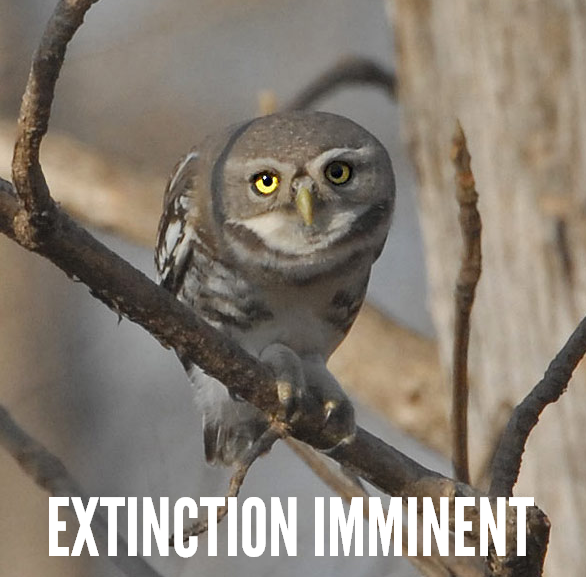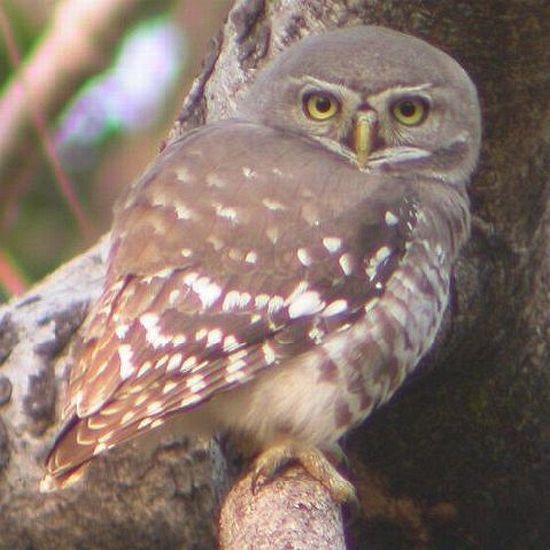Endangered Species Monday | Heteroglaux blewitti - Extinction is now Imminent.

Endangered Species Monday | Heteroglaux blewitti - Extinction is now Imminent
This Mondays (ESP) article (Endangered Species Article), I am am documenting yet again on a species of forest owl (being the third time). This time I know for sure the species is going to go extinct - and sadly there is little that can be done to preserve the bird, although environmentalists are still battling, unfortunately it’s not looking good at all. (Image Credit: Birds of the Bible for Kids).
Listed as (critically endangered), the species was identified back in 1873 by Dr Allan Octavian Hume CB (6 June 1829 – 31 July 1912) was a civil servant, political reformer, ornithologist and botanist who worked in British India. He was one of the founders of the Indian National Congress, a political party that was later to lead in the Indian independence movement. A notable ornithologist, Dr Hume has been called “the Father of Indian Ornithology” and, by those who found him dogmatic, “the Pope of Indian ornithology.”
As an administrator of Etawah, he saw the Indian Rebellion of 1857 as a result of misgovernance and made great efforts to improve the lives of the common people. The district of Etawah was among the first to be returned to normalcy and over the next few years Dr Hume’s reforms led to the district being considered a model of development. Dr Hume rose in the ranks of the Indian Civil Service but like his father Joseph Hume, the radical MP, he was bold and outspoken in questioning British policies in India.
He rose in 1871 to the position of secretary to the Department of Revenue, Agriculture, and Commerce under Lord Mayo. His criticism of Lord Lytton however led to his removal from the Secretariat in 1879. Back in 1988 the Forest Spotted Owlet was listed by environmentalists as threatened. Unfortunately since the 1980’s habitat destruction, poaching, deforestation and gradual human population increases have skyrocketed.
“CONTRADICTIONS”
Conservationists allegedly from 1994-2012 battled hard to preserve the species of Spotted Owlet, regrettably their battles have been lost. Back in 2013 a further census was undertaken of which proved the species was nearing complete extinction within the wild. Today (2016) its incredibly likely we’ll lose the Spotted Owlet from all of its range.
Endemic only to India there is estimated to be (from the last census of 2013) a depressing total of 50-260 mature individuals remaining. The total number of “sub-populations has been identified as 2-100. Furthermore within the past ten years from 2006-2016 there has a been “ALLEGEDLY” a continuous population decrease of exactly 10%-19%. International Animal Rescue Foundation India has also reported within the past four years that “very small populations known are still decreasing”, and from records kept the species is highly likely to be extinct within the next 730 days, which is exactly two years.

Image credit: Ashley Banwell / World Birders
The International Union for the Conservation of Nature RED LIST have ‘deliberately lied’ and ‘misinformed the general public’ stating the the bird listed hereto was extant from the years of 1988-1996. Conservationists from International Animal Rescue Foundation India in New Delhi hasn’t no reports from 1988-1996 because the bird was only re-discovered in 1997 after it was described in 1873, and it was not seen after 1884 and considered extinct until it was rediscovered 113 years later in 1997 by Pamela Rasmussen. Source: Ripley, S. D. (1976). “Reconsideration of Athene blewitti (Hume).”. J. Bombay Nat. Hist. Soc. 73: 1–4.
So whatever the IUCN are talking about is either codswallop or deliberate misinformation to garner further donations from the public?. I mean how on earth can one make this absurd lie up? Maybe the IUCN can produce documented evidence that proves the species has been active from the 1980’s to 1997? I highly doubt that they can, furthermore this lie (among many more) also brings into question any other lies the organisation “may have been publishing within the public domain” to misinform the general public?
Moving on - the population is estimated (as explained) to number 50-249 mature individuals based on the number of records from known sites, with c. 100 individuals now recorded from Melghat Tiger Reserve. This estimate is equivalent to 75-374 individuals in total, rounded here to 70-400 individuals. Given the increasing number of records and sites known within its range it may prove to be more common than previous evidence has suggested.
Trend Justification: The species faces a number of threats which in combination are suspected to be causing a decline at a rate of 10-19% over ten years.
THREATS
Listed on CITES APPENDIX I (The highest listing) meaning all hunting, poaching and any trade of this species is strictly forbidden (unless otherwise stated). Given its rarity, identification of threats is difficult. Forest in its range is being lost and degraded by illegal tree cutting for firewood and timber, and encroachment for cultivation, grazing and settlements, as well as forest fires and minor irrigation dams.
The site of its initial discovery in 1872 (Chhattisgarh) has completely been encroached by agriculture. Large areas of forest in the Yawal Wildlife Sanctuary and Yawal Forest Division as well as the Aner Wildlife Sanctuary and the Satpuda mountain ranges in Maharashtra have recently been subject to encroachment leading to habitat loss for this species.
It is likely that other forest areas where it occurs are under similarly intense pressure. Overgrazing by cattle may reduce habitat suitability. The proposed Upper Tapi Irrigation Project threatens 244 ha of prime habitat used by the species. It suffers predation from a number of native raptors, limiting productivity, and it faces competition for a limited number of nesting cavities.
The species is hunted by local people and body parts and eggs are used for local customs, such as the making of drums. Pesticides and rodenticides are used to an unknown degree within its range and may pose an additional threat.
These owls typically hunt from perches where they sit still and wait for prey. When perched they flick their tails from side to side rapidly and more excitedly when prey is being chased. It was observed in one study that nearly 60% of prey were lizards (including skinks), 15% rodents, 2% birds and the remaining invertebrates and frogs. When nesting the male hunted and fed the female at nest and the young were fed by the female.
The young fledge after 30–32 days. The peak courtship season is in January to February during which time they are very responsive to call playback with a mixture of song and territorial calls. They appear to be strongly diurnal although not very active after 10 AM, often hunting during daytime. On cold winter mornings they bask on the tops of tall trees. Filial cannibalism by males has been observed.
Thank you for reading.
Dr Jose Carlos Depre - PhD. MEnvSc. BSc(Hons) Botany, PhD(NeuroSci) D.V.M.
Environmental, Botanical & Human Scientist.
www.speakupforthevoiceless.org



Thank you for your reply, should it merit a response we will respond in due course. This site is owned by International Animal Rescue Foundation and moderation is used.